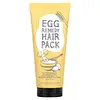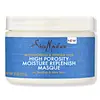What's inside
What's inside
 Key Ingredients
Key Ingredients

No key ingredients
 Benefits
Benefits

 Concerns
Concerns

 Ingredients Side-by-side
Ingredients Side-by-side

Water
Skin ConditioningCetearyl Alcohol
EmollientGlycerin
HumectantDimethicone
EmollientCyclopentasiloxane
EmollientAmodimethicone
Behentrimonium Chloride
PreservativeSteartrimonium Chloride
PreservativeEgg Yolk Extract
EmulsifyingBehenyl Alcohol
EmollientPropylene Glycol
HumectantHydrogenated Polyisobutene
EmollientOleth-2
EmulsifyingStearamidopropyl Dimethylamine
EmulsifyingButylene Glycol
HumectantParfum
MaskingQuaternium-18
Isopropyl Alcohol
SolventBeeswax
Emulsion StabilisingBehentrimonium Methosulfate
Hydroxyethyl Urea
HumectantPanthenyl Ethyl Ether
Citric Acid
BufferingTocopheryl Acetate
AntioxidantGuar Hydroxypropyltrimonium Chloride
Skin ConditioningArachidyl Alcohol
EmollientStearyl Alcohol
EmollientOlea Europaea Fruit Oil
MaskingPersea Gratissima Oil
Skin ConditioningCetrimonium Chloride
AntimicrobialSodium Benzoate
MaskingLaureth-5
EmulsifyingButyrospermum Parkii Butter
Skin Conditioning1,2-Hexanediol
Skin ConditioningPotassium Sorbate
PreservativeDisodium EDTA
Argania Spinosa Kernel Oil
EmollientGarcinia Indica Seed Butter
Skin ConditioningTheobroma Cacao Seed Butter
EmollientBambusa Vulgaris Water
Skin ConditioningCamellia Sinensis Leaf Water
MaskingAlbumen Extract
EmollientHydrolyzed Wheat Protein
Skin ConditioningAdansonia Digitata Seed Extract
Skin ConditioningOctyldodecanol
EmollientSodium PCA
HumectantCI 19140
Cosmetic ColorantSodium Lactate
BufferingHydrolyzed Collagen
EmollientArginine
MaskingHydrogenated Lecithin
EmulsifyingAspartic Acid
MaskingAvena Sativa Protein Extract
Skin ConditioningCeramide NP
Skin ConditioningGelatin
Hydrolyzed Keratin
HumectantPCA
HumectantPhenoxyethanol
PreservativeAvena Sativa Kernel Extract
AbrasiveHydrolyzed Silk
HumectantCI 15985
Cosmetic ColorantGlycine
BufferingAlanine
MaskingHydrolyzed Corn Protein
Skin ConditioningHydrolyzed Soy Protein
HumectantSerine
MaskingValine
MaskingIsoleucine
Skin ConditioningProline
Skin ConditioningThreonine
Caprylyl Glycol
EmollientHistidine
HumectantPhenylalanine
MaskingGlycine Soja Seed Extract
Skin ConditioningHoney Extract
HumectantVanilla Planifolia Fruit Extract
Skin ConditioningEthylhexylglycerin
Skin ConditioningMilk Protein Extract
Water, Cetearyl Alcohol, Glycerin, Dimethicone, Cyclopentasiloxane, Amodimethicone, Behentrimonium Chloride, Steartrimonium Chloride, Egg Yolk Extract, Behenyl Alcohol, Propylene Glycol, Hydrogenated Polyisobutene, Oleth-2, Stearamidopropyl Dimethylamine, Butylene Glycol, Parfum, Quaternium-18, Isopropyl Alcohol, Beeswax, Behentrimonium Methosulfate, Hydroxyethyl Urea, Panthenyl Ethyl Ether, Citric Acid, Tocopheryl Acetate, Guar Hydroxypropyltrimonium Chloride, Arachidyl Alcohol, Stearyl Alcohol, Olea Europaea Fruit Oil, Persea Gratissima Oil, Cetrimonium Chloride, Sodium Benzoate, Laureth-5, Butyrospermum Parkii Butter, 1,2-Hexanediol, Potassium Sorbate, Disodium EDTA, Argania Spinosa Kernel Oil, Garcinia Indica Seed Butter, Theobroma Cacao Seed Butter, Bambusa Vulgaris Water, Camellia Sinensis Leaf Water, Albumen Extract, Hydrolyzed Wheat Protein, Adansonia Digitata Seed Extract, Octyldodecanol, Sodium PCA, CI 19140, Sodium Lactate, Hydrolyzed Collagen, Arginine, Hydrogenated Lecithin, Aspartic Acid, Avena Sativa Protein Extract, Ceramide NP, Gelatin, Hydrolyzed Keratin, PCA, Phenoxyethanol, Avena Sativa Kernel Extract, Hydrolyzed Silk, CI 15985, Glycine, Alanine, Hydrolyzed Corn Protein, Hydrolyzed Soy Protein, Serine, Valine, Isoleucine, Proline, Threonine, Caprylyl Glycol, Histidine, Phenylalanine, Glycine Soja Seed Extract, Honey Extract, Vanilla Planifolia Fruit Extract, Ethylhexylglycerin, Milk Protein Extract
Water
Skin ConditioningCetearyl Alcohol
EmollientButyrospermum Parkii Butter
Skin ConditioningCaprylic/Capric Triglyceride
MaskingStearamidopropyl Dimethylamine
EmulsifyingBehentrimonium Chloride
PreservativeParfum
MaskingHydrogenated Vegetable Oil
EmollientSchinziophyton Rautanenii Kernel Oil
EmollientSimmondsia Chinensis Seed Oil
EmollientAloe Barbadensis Leaf Juice
Skin ConditioningAdansonia Digitata Seed Oil
EmollientPanthenol
Skin ConditioningHydroxyethylcellulose
Emulsion StabilisingSodium Chloride
MaskingPolysorbate 60
EmulsifyingDisodium Phosphate
BufferingCaprylyl Glycol
EmollientSodium Citrate
BufferingBenzoic Acid
MaskingWater, Cetearyl Alcohol, Butyrospermum Parkii Butter, Caprylic/Capric Triglyceride, Stearamidopropyl Dimethylamine, Behentrimonium Chloride, Parfum, Hydrogenated Vegetable Oil, Schinziophyton Rautanenii Kernel Oil, Simmondsia Chinensis Seed Oil, Aloe Barbadensis Leaf Juice, Adansonia Digitata Seed Oil, Panthenol, Hydroxyethylcellulose, Sodium Chloride, Polysorbate 60, Disodium Phosphate, Caprylyl Glycol, Sodium Citrate, Benzoic Acid
Ingredients Explained
These ingredients are found in both products.
Ingredients higher up in an ingredient list are typically present in a larger amount.
This ingredient is a preservative and often used for it's anti-static properties. You'll most likely see this ingredient in hair conditioners.
It does not cause irritation or sensitization in leave-on products at 1-5%.
This ingredient is also known as shea butter. It is an effective skin hydrator and emollient.
Emollients help soothe and soften your skin. It does this by creating a protective film on your skin. This barrier helps trap moisture and keeps your skin hydrated. Emollients may be effective at treating dry or itchy skin.
Shea butter is rich in antioxidants. Antioxidants help fight free-radicals, or molecules that may harm the body. It is also full of fatty acids including stearic acid and linoleic acid. These acids help replenish the skin and keep skin moisturized.
While Shea Butter has an SPF rating of about 3-4, it is not a sunscreen replacement.
Shea butter may not be fungal acne safe. We recommend speaking with a professional if you have any concerns.
Learn more about Butyrospermum Parkii ButterCaprylyl Glycol is a humectant and emollient, meaning it attracts and preserves moisture.
It is a common ingredient in many products, especially those designed to hydrate skin. The primary benefits are retaining moisture, skin softening, and promoting a healthy skin barrier.
Though Caprylyl Glycol is an alcohol derived from fatty acids, it is not the kind that can dry out skin.
This ingredient is also used as a preservative to extend the life of products. It has slight antimicrobial properties.
Learn more about Caprylyl GlycolCetearyl alcohol is a mixture of two fatty alcohols: cetyl alcohol and stearyl alcohol. It is mainly used as an emulsifier. Emulsifiers help prevent the separation of oils and products. Due to its composition, it can also be used to thicken a product or help create foam.
Cetearyl alcohol is an emollient. Emollients help soothe and hydrate the skin by trapping moisture.
Studies show Cetearyl alcohol is non-toxic and non-irritating. The FDA allows products labeled "alcohol-free" to have fatty alcohols.
This ingredient is usually derived from plant oils such as palm, vegetable, or coconut oils. There is debate on whether this ingredient will cause acne.
Due to the fatty acid base, this ingredient may not be Malassezia folliculitis safe.
Learn more about Cetearyl AlcoholParfum is a catch-all term for an ingredient or more that is used to give a scent to products.
Also called "fragrance", this ingredient can be a blend of hundreds of chemicals or plant oils. This means every product with "fragrance" or "parfum" in the ingredients list is a different mixture.
For instance, Habanolide is a proprietary trade name for a specific aroma chemical. When used as a fragrance ingredient in cosmetics, most aroma chemicals fall under the broad labeling category of “FRAGRANCE” or “PARFUM” according to EU and US regulations.
The term 'parfum' or 'fragrance' is not regulated in many countries. In many cases, it is up to the brand to define this term.
For instance, many brands choose to label themselves as "fragrance-free" because they are not using synthetic fragrances. However, their products may still contain ingredients such as essential oils that are considered a fragrance by INCI standards.
One example is Calendula flower extract. Calendula is an essential oil that still imparts a scent or 'fragrance'.
Depending on the blend, the ingredients in the mixture can cause allergies and sensitivities on the skin. Some ingredients that are known EU allergens include linalool and citronellol.
Parfum can also be used to mask or cover an unpleasant scent.
The bottom line is: not all fragrances/parfum/ingredients are created equally. If you are worried about fragrances, we recommend taking a closer look at an ingredient. And of course, we always recommend speaking with a professional.
Learn more about ParfumWe don't have a description for Stearamidopropyl Dimethylamine yet.
Water. It's the most common cosmetic ingredient of all. You'll usually see it at the top of ingredient lists, meaning that it makes up the largest part of the product.
So why is it so popular? Water most often acts as a solvent - this means that it helps dissolve other ingredients into the formulation.
You'll also recognize water as that liquid we all need to stay alive. If you see this, drink a glass of water. Stay hydrated!
Learn more about Water